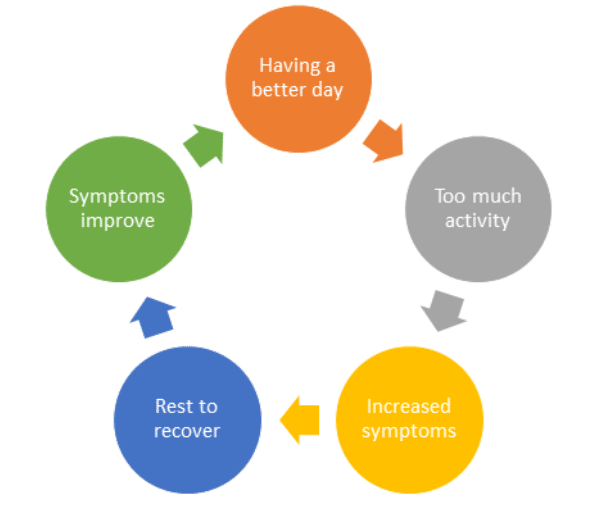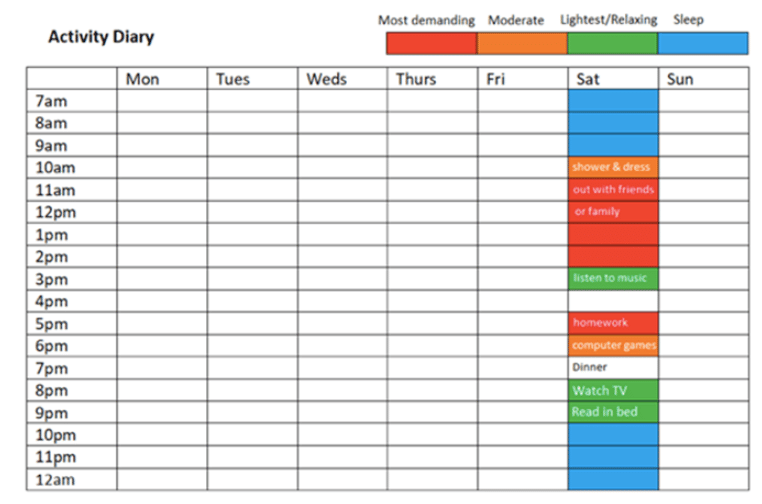Managing daily activity
While you are experiencing long COVID symptoms, you might find that you need to rest or sleep more as you recover. During this time, you may also find that your symptoms get worse after doing certain activities.
It is important not to rush back to activities too quickly, or before you feel ready – it can be helpful to build up your activity gradually while you are recovering.
There are ways to help you to manage activity, to get back to the things you want to do.
The information below provides suggestions for actions that you can take to help you manage your own recovery. Remember that everyone is different, and you might need to adapt things for your own situation.
Types of activity
Activities can be a mixture of physical and cognitive tasks. All activities use energy. Each person may find different activities more or less demanding.
Pacing
Pacing is a way of balancing activity and rest. It can help you to manage your symptoms better and keep your energy levels more consistent.
It can be frustrating and upsetting when you cannot do the things you want to do. It can also be tempting to do more on a day when you feel better, or when you might miss an important activity. This can make your symptoms worse and be followed by a period of having to rest more to recover.
We call this activity pattern ‘boom and bust’. Over time, boom and bust can lead to less activity and it can make it more difficult to manage your symptoms.

Starting a routine
It is important to have a good pattern of sleep, mealtimes, activity and rest. Developing a daily routine that has some flexibility, can be helpful and can also help you sleep better.
Using an activity diary or tracker can be a helpful way to make realistic activity plans.
Filling in an activity diary for 1 to 2 weeks can help you identify patterns in your current activity.
Here is an example with one day partially filled in. Try to fill in the whole week to see your overall activity and types of activity.

Your baseline is the amount of activity you can do consistently without making your symptoms worse. This can be for a single activity or for a number of activities over a day a week.
Your baseline should be established from what you can usually do on any given day, rather than what you can do on your best days. It is better to do a little activity more often, rather than a lot of activity occasionally.
Example of baseline for an activity
If you can walk for 20 minutes on a good day but you could only walk for 5 minutes comfortably on most days, your baseline for walking is 5 minutes.
Getting regular, good quality rest is important for your recovery.
Restful activities are different for everyone.
- Try different relaxing activities such as reading, drawing, listening to music, simple breathing exercises or mindfulness
- Try to avoid using screens when resting
- Try to avoid sleeping during the day, as this can have a negative impact on the quality of your night-time sleep
- Taking regular rests to recharge and recover will help you to manage your energy – try to take regular rest breaks, so that you don’t get over-tired
- Stick to activity plans that you have set yourself to avoid a boom and bust pattern
- Spread activities evenly over the day and the week
- Remember to take regular breaks to rest between activities
- It can be helpful to alternate physical and cognitive activities
- Planning what you are going to do in advance can help you stick to your baseline
Do the activities you enjoy
It is important to include a variety of activities in your daily routine, including those you find enjoyable e.g. participating in school work, leisure and social tasks.
You may need to do things slightly differently at first.
If you wanted to bake a cake, but think it might be too much for you, see if you can do things differently. This could be starting with a simple recipe, breaking the task down into smaller chunks, getting some help, taking regular rest breaks, or sitting-down rather than standing up.
You might find it helpful to focus on one activity at a time, and limit other distractions that might make concentrating more difficult. For example, putting your phone away and sitting in a calm quiet space to read or study.
Pacing can be tricky and you may not always get it right. Sticking to planned amounts of activity as much as possible is a good way to start.
If you think you have set your baseline too high or too low you can always adjust it. As your symptoms improve you might be able to relax the rules a bit if there is something important that you want to join in with.
Key Points
PLAN: find a manageable amount of activity that works for you (a baseline) and then spread activities over the day and week
PRIORITISE: important activities, including something you enjoy
PACE: stick to the planned amounts of activity even on a good day (and try some activity even on a worse day) – when you are comfortable you can start to build up on your baseline and take rest breaks and stop before you get exhausted
Increasing activity
It is important to increase activity levels slowly. Look at your overall activity and try not to build up everything at once. Decide on your priorities and goals. Try to gradually build-up one activity at a time, adding in new activities when you feel ok with your current level.
You might find that your symptoms affect your concentration and memory, which may affect your schoolwork as well as other activities. Once you have established your baseline you might feel ready to start building your concentration and memory. The ‘little and often’ principle still applies.
- Setting alarms, or writing reminders or checklists might be helpful to remember important things
- Focus on one activity at a time and minimise any distractions – for example, turn off your phone, study in a calm and quiet space
- Reading short magazine articles or a book you are familiar with, or listening to an audiobook, can be a good place to start
- Focus on the activity for the length of time that you have identified as your baseline, and try to remember what you have read, using bullet points or by talking to someone
- When you are comfortable at your baseline you can start to gradually increase the amount of time that you study for in small chunks separated by a rest break – you might start to answer study questions in bullet points at first, before worrying about full sentences or essays
- Using spider plans or mind maps can be a good way to improve your memory
Children and young people with long COVID symptoms such as fatigue, commonly report an increase in symptoms after physical activity, such as after washing and dressing, or after higher intensity activities, such as doing PE at school.
Finding a manageable way to maintain and gradually increase physical activity can help you to work towards your goals. Our bodies need to move, so try to find some activity or movement which suits you. Take it gently to start with, and do not push through symptoms.
- Start with a small amount of gentle activity that you can do on most days (not just on a good day) and without increasing your symptoms
- Try some gentle stretches, a short walk, dance around your room, or a functional activity, such as baking
- Try a few activities for different lengths of time to work out what is manageable for you
- When you can carry out activity regularly without increasing symptoms, you can start to increase the amount slowly
It can be normal to feel a bit more tired, have ‘jelly legs’ or some mild muscle soreness when you increase your activity levels. This should settle down as your body adjusts. If your symptoms do not settle down in a day or two, or get worse, you might have set your baseline too high. Think about how you could try reducing it next time.
Depending on your symptoms you might need to adapt activities to find something that works for you. For example, if you feel dizzy when standing up, you might want to start activities or exercises in a lying or sitting position, and then gradually progressing to more ‘upright’ activities.
If you have concerns about symptoms of chest pain, shortness of breath, palpitations or dizziness, check with your doctor before increasing your activity.
Key Points:
- Start low, go slow
- Do not rush back to high intensity activities too quickly
- Build up gradually to allow your body time to adjust
After increasing activity levels, continue at this new baseline until it feels more manageable and does not make your symptoms worse. You can then increase the level again. It might take a few weeks until you are ready to increase your activities again.
Sometime people’s symptoms worsen e.g. when they catch a cold, or for no obvious reason, then readjust and decrease the level of activity. It can be like snakes and ladders rather than a straight line to recovery.
Remember to look at your overall activity when building up. When other demands are high, for example, the start of the school term or exam time, it might not be a good time to increase your physical activity levels. School holidays might be a good time to increase activity levels when there is less pressure from school. Make sure you include activities that you enjoy.
Gradually build up your fitness levels before returning to vigorous sport or PE. When you feel ready to start PE again, perhaps start by joining in the warm-up sessions or part of the PE lesson, or take regular rest breaks during the session. Talk with your teacher first so that they understand that you might need support with this.
Your family, friends, school or sports coaches can support you in your activity management and recovery. If you think you need more specialist support from a physiotherapist or occupational therapist, you should discuss this with your doctor.
- Physical activity can be challenging when you have long COVID symptoms
- Start by finding a manageable level and amount of activity (baseline)
- When you are comfortable with your activity baseline, build it up gradually
- Start with lower-intensity activities
- Do not rush back to vigorous physical activities.
- Continue to pace activity and schedule in regular rest breaks
- Stabilise activity levels between increases to allow your body to adjust – include some enjoyable activity, even if you have to do things differently
- Listen to your body, review and adjust your plan as needed
- This will take time – there will be successes and there will be times where it feels you are back to the beginning, but every step is still a step forwards in learning how to manage your symptoms
